Abstract
The paper examines the relationship between exchange rates and share prices using the wavelets approach, and more specifically the continuous wavelet power spectrum, cross-wavelet transform, and cross-wavelet coherency. Our results, based on Indian data, lend support to the traditional (Am Econ Rev 70:960–971, 1980) as well as the new portfolio hypothesis (Am Econ Rev 83:1356–1369, 1993), albeit over different time periods and across different time scales. The wavelet approach used in the paper has helped to uncover some interesting economic relationships within the time–frequency domain which have remained hidden thus far.




Similar content being viewed by others
Notes
Aguiar-Conraria et al. (2008) is the first study to examine macroeconomic relations using continuous wavelets.
The description of CWT, XWT, and WTC is drawn from the work of Grinsted et al. (2004). We are grateful to Grinsted and co-authors for making the codes available at: http://www.pol.ac.uk/home/research/waveletcoherence/ which we used in the present study.
References
Abdalla I, Murinde V (1997) Exchange rates and stock price interactions in emerging financial markets: evidence on India, Korea, Pakistan and the Philippines. Applied Financ Econ 7:25–35
Aggarwala R (1981) Exchange rates and stock prices: a study of the us capital markets under floating exchange rates. Akron Bus Econ Rev 12:7–12
Aguiar-Conraria L, Azevedo N, Soares MJ (2008) Using wavelets to decompose the time-frequency effects of monetary policy. Phys A 387:2863–2878
Aguiar-Conraria L, Soares MJ (2011a) Oil and the macroeconomy: using wavelets to analyze old issues. Empir Econ 40:645–655
Aguiar-Conraria L, Soares MJ (2011b) Business cycle synchronization and the Euro: a wavelet analysis. J Macroecon 33(3):477–489
Ajayi AR, Mougoue M (1996) On the dynamic relation between stock prices and exchange rates. J Financ Res XIX(2):193–207
Ajayi RA, Friedman J, Mehdian SM (1998) On the relationship between stock returns and exchange rates: tests of granger causality. Glob Financ J 9:241–251
Baubeau P, Cazelles B (2009) French economic cycles: a wavelet analysis of French retrospective GNP series. Cliometrica 3:275–300
Bhattacharya B, Mukherjee J (2003) Causal relationship between stock market and exchange rate. foreign exchange reserves and value of trade balance: a case study for India. Paper presented at the Fifth Annual Conference on Money and finance in the Indian economy, Jan 2003
Caraiani P (2012) Stylized facts of business cycles in a transition economy in time and frequency. Econ Modell 29(6):2163–2173
Crowley P, Mayes D (2008) How fused is the Euro area core?: an evaluation of growth cycle co-movement and synchronization using wavelet analysis. J Bus Cycle Meas Anal 4:63–95
Dacorogna M, Gençay R, Müller U, Olsen R, Pictet V (2001) An introduction to high-frequency finance. Academic Press, San Diego, California
Dornbusch R, Fischer S (1980) Exchange rates and current account. Am Econ Rev 70:960–971
Frank P, Young A (1972) Stock price reaction of multinational firms to exchange realignments. Financ Manag 1(3):66–73
Frankel J (1993) Does foreign exchange intervention matter? The portfolio effect. Am Econ Rev 83:1356–1369
Gabor D (1946) Theory of communication. J Inst of Electr Eng 93:429–457
Gallegati M, Ramsey JB, Semmler W (2011) The US wage Phillips curve across frequencies and over time. Oxf Bull Econ Stat 73(4):0305–9049
Ge Z (2007) Significance tests for the wavelet power and the wavelet power spectrum. Ann Geophys 25:2259–2269
Ge Z (2008) Significance tests for the wavelet cross spectrum and wavelet linear coherence. Ann Geophys 26:3819–3829
Granger CWJ, Huang BN, Yang CW (2000) A bivariate causality between stock prices and exchange rates: evidence from recent Asian flu. Q Rev of Econ Financ 40:337–354
Grinsted A, Moore JC, Jevrejeva S (2004) Application of the cross wavelet transform and wavelet coherence to geophysical time series. Nonlinear Process Geophys 11:561–566
Hudgins L, Friehe C, Mayer M (1993) Wavelet transforms and atmospheric turbulence. Phys Rev Lett 71(20):3279–3282
Jammazi R (2012) Cross dynamics of oil-stock interactions: a redundant wavelet analysis. Energy 44(1):750–777
Ma KC, Kao GW (1990) On exchange rate changes and stock price reactions. J Bus Account 17(3):441–449
Madaleno M, Pinho C (2012) International stock market indices comovements: a new look. Int J Financ Econ 17:89–102
Maraun D, Kurths J (2004) Cross wavelet analysis: significance testing and pitfalls. Nonlinear Processes Geophys 11:505–514
Maraun D, Kurths J, Holschneider M (2007) Non-stationary Gaussian processes in wavelet domain: Synthesis, estimation, and significance testing. Phys Rev E 75(016707):1–14
Mishra AK (2004) Stock market and foreign exchange market in India: are they related? South Asia Econ J 5:209–232
Muhammad N, Rasheed A (2002) Stock prices and exchange rates: are they related? evidence from south asian countries. Paper presented at the 18th Annual general meeting and conference, Pakistan society of development economists, Islamabad, 13–15 Jan 2003
Phylaktis K, Ravazzolo F (2000) Stock prices and exchange rate dynamics. pp. 17–37. See at http://www.cass.city.ac.UK/emg/workingpapers/stock-prices-and-exchange.pdf Accessed 07 July 2012
Rahman L, Uddin J (2009) Dynamic relationship between stock prices and exchange rates: evidence from three south Asian countries. Int Bus Res 2(2):167–174
Raihan S, Wen Y, Zeng B (2005) Wavelet: a new tool for business cycle analysis. Working Paper 2005–050A, Federal Reserve Bank of St. Louis
Rua A (2012) Money growth and inflation in the Euro Area: a time–frequency view. Oxf Bull Econ Stat 74(6):0305–9049
Rua A, Nunes LC (2009) International co-movement of stock market returns: a wavelet analysis. J Empir Financ 16:632–639
Smith C (1992) Stock markets and the exchange rate: a multi-country approach. J Macroecon 14(4):607–629
Soenen L, Hennigar E (1988) An analysis of exchange rates and stock prices-the us experience between 1980s and 1986. Akron Bus Econ Rev 19(4):71–76
Solonik B (1987) Using financial prices to test exchange models. A note. J Financ 42(1):141–149
Tiwari AK, Dar AB, Bhanja N (2013) Oil price and exchange rates: a wavelet based analysis for India. Econ Modell 31:414–422
Torrence C, Compo GP (1998) A practical guide to wavelet analysis. Bull Am Meteor Soc 79:605–618
Torrence C, Webster P (1999) Interdecadal changes in the esnom on soon system. J Clim 12:2679–2690
Venkateshwarlu M, Tiwari R (2005) Causality between stock prices and exchange rates: some evidence for India. ICFAI J Appl Financ 11:5–15
Acknowledgments
We are very thankful to the reviewers for pointing out some very critical issues that helped us to improve the quality of the paper. We also express our gratitude to them for providing us with relevant references. Standard caveats apply.
Author information
Authors and Affiliations
Corresponding author
Rights and permissions
About this article
Cite this article
Tiwari, A.K., Bhanja, N., Dar, A.B. et al. Time–frequency relationship between share prices and exchange rates in India: Evidence from continuous wavelets. Empir Econ 48, 699–714 (2015). https://doi.org/10.1007/s00181-014-0800-3
Received:
Accepted:
Published:
Issue Date:
DOI: https://doi.org/10.1007/s00181-014-0800-3




